Generating 700+ Articles In 24 Months: An AI Content Creation Case Study

Would you like to jump on board the “AI content creation” train but feel you are falling behind?
Do you want to use AI to get off the hamster wheel of manual content creation?
Trust me, I feel you.
Been there, felt that.
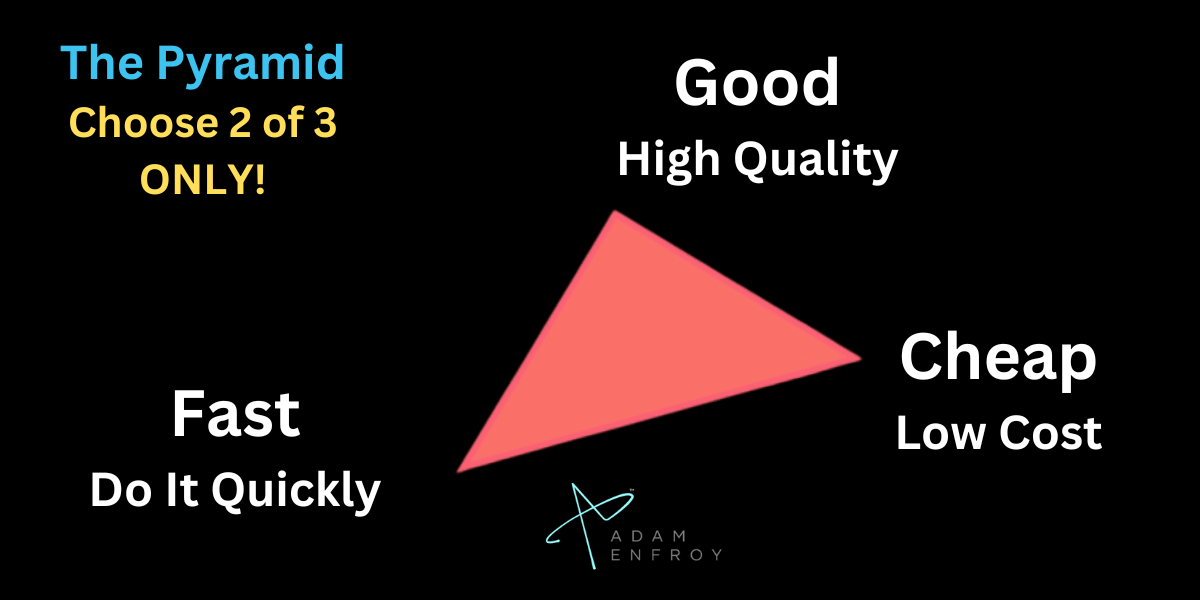
Picking only 2 out of 3?
Scratch that!
I wanted to pick all 3!
But to do so, I quickly realized that I had to create a framework.
A framework that allowed me to produce over 700 articles in less than two years for AdamEnfroy.com
Each article averaged 2000-3000 words.
It took around 3.1 hours to write a single article.
In a pre-AI world, this would have taken much longer to complete.
In a normal AI world, the quality wouldn’t have been there.
Overall, having an AI framework made it possible to produce quality content on a grand scale.
In this article, I’ll share with you:
- what I learned from implementing AI content creation in our business
- the pitfalls I encountered and
- how to make it work for your own projects.
AI Checklist: The Tools You’ll Need to Follow Along
Scaling AI content begins with the right toolkit.
I used the following AI writing tools to generate 700+ AI articles in the last 24 months.
If you want to mass-produce high-quality AI content, these AI content generator options can make your life (one hundred times) easier.
The right tools can also help you create social media posts, converting ads, and more.
AI Content Creation Tools
The right content creation tools save time, money and effort. They also make the job easier to do.
I love (and still do) using Jasper.
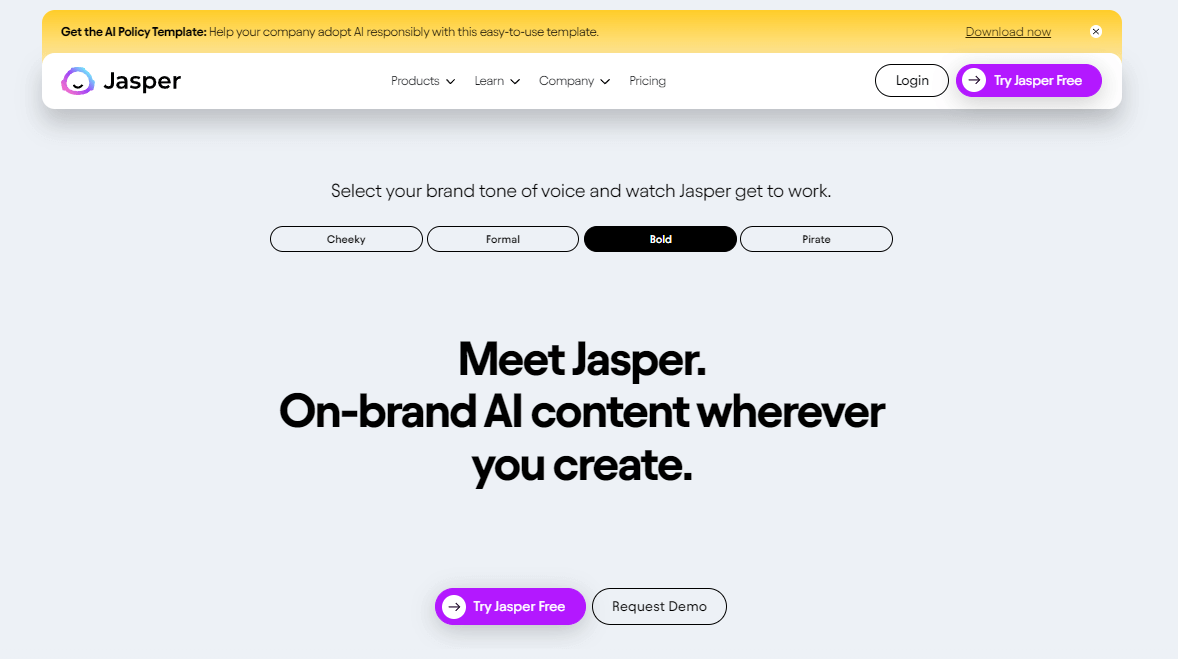
You might know it as Conversion.ai or even Jarvis – there’s been a few name changes.
This AI content creation tool offers many templates.
The most well-known is “Boss Mode”.
I explain more about how I used this template (and Jasper in general) later in this article.
Surfer SEO
Creating reports in Surfer SEO is the first step.
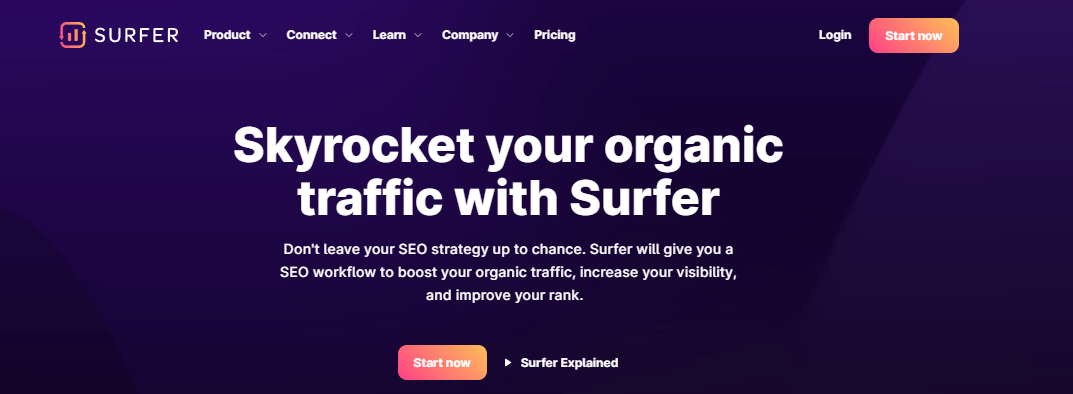
This tool breaks down the content’s keyword usage.
You can see the keywords your content is lacking and that you need to add.
These missing keywords are vital for enhancing SEO effectiveness.
The goal is to achieve a Surfer score of 70+.
This high score reflects well-optimized content.
This increases the chances of ranking high on search engines.
Remember, the goal is not just to stuff keywords but to place them naturally.
Make Your Content Better with Grammarly
I use Grammarly to help make the content better sounding and easier to consume.
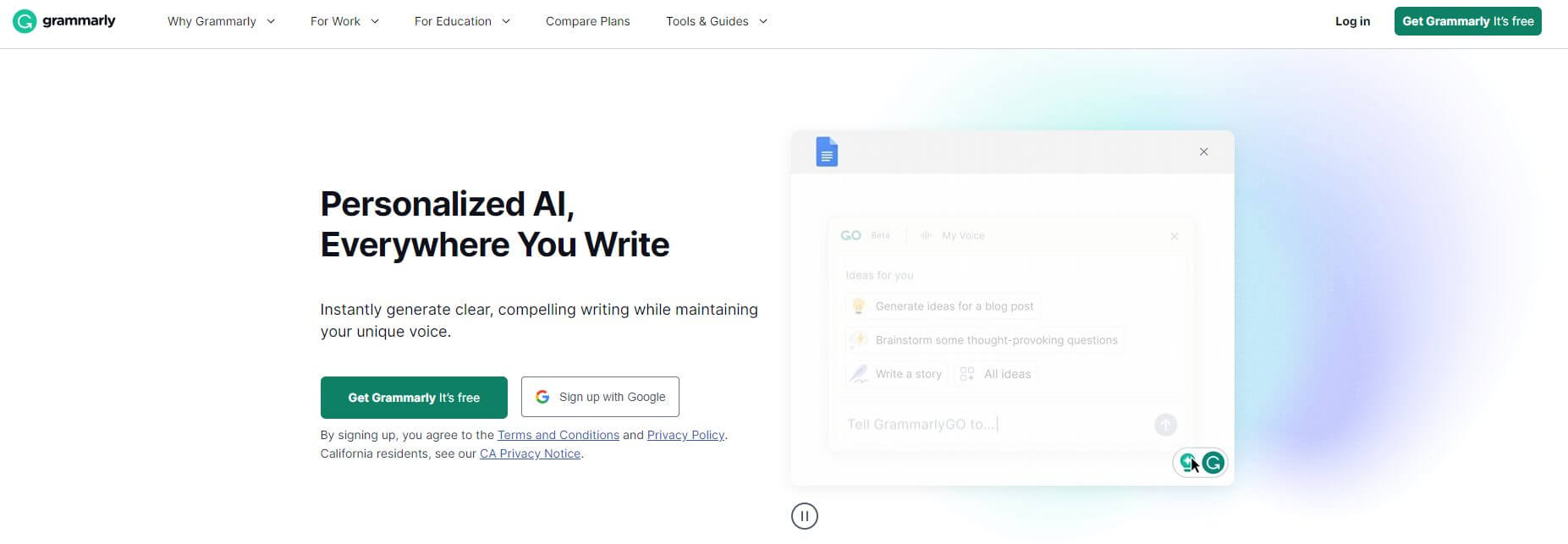
Grammarly helps me:
- spot mistakes in the text
- makes writing easy to read
- helps get a score of 60+.
I also aim to get less than ten error suggestions from Grammarly.
These numbers ensure the final output is free of typos and errors.
You can also use grammar checkers to get the job done.
Check The Article In Copyscape
Copyscape is a powerful tool for finding text snippets that already exist online.
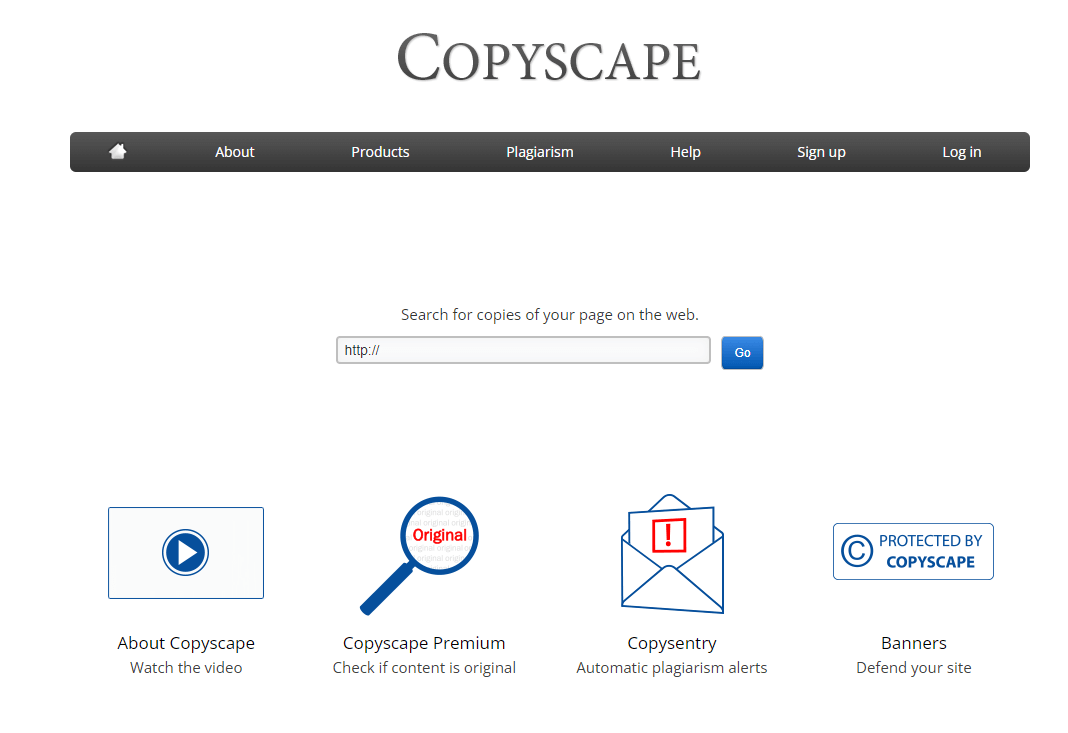
Uniqueness is key in creating content that stands out and ranks well.
Unique content helps us build trust with our readers. It also makes our content more interesting and engaging.
If I find matching text through Copyscape, I make changes to our content so it’s more personalized to the voice we’re using.
Use Images Correctly
When it comes to adding images, make sure they are relevant.
You can use images to break up the content, making it more visually appealing.
Use reputable websites like Adobe Stock or Pixabay when sourcing images.

You can also create images with Canva. When using an existing image, always include attribution and a link to the original source.
Match Search Intent = Quality Content
If you don’t take anything else from this article, remember this:
Understanding search intent is critical for your SEO strategy to work.
The core of any search lies in the intent.
Google is constantly on the lookout for people gaming the system with low-quality AI content.
Here’s what happens if you create content that doesn’t provide any value to the user.
At best, your content will get stuck on page 2 or 3 (or 100) in the SERPs.
At worst, Google will remove it from the search engine altogether and consider your site as one producing junk content.
Moreover, search intent is a human element.
It requires a human touch to make it make sense.
Users type in queries with a specific goal in mind.
Whether it’s:
- Finding a recipe for chocolate chip cookies
- Buying a new television
- Or learning about the life cycle of a butterfly
…search engines have evolved to understand this intent.
This is how they provide the most relevant results.
Here’s a video I recorded regarding Search Generative Experience.
It can give you a better idea of what I’m talking about.
But Why Should YOU Understand Search Intent?
Understanding search intent is the same as having a roadmap to creating effective content.
You can tailor your content to meet these specific needs by determining the goal behind a user’s search query.
Stop guessing what your audience wants – instead, provide precisely the information they’re seeking.
This makes your content more attractive, leading to:
- higher click-through rates
- increased time on page
- and better overall engagement.
The Various Types Of Searches
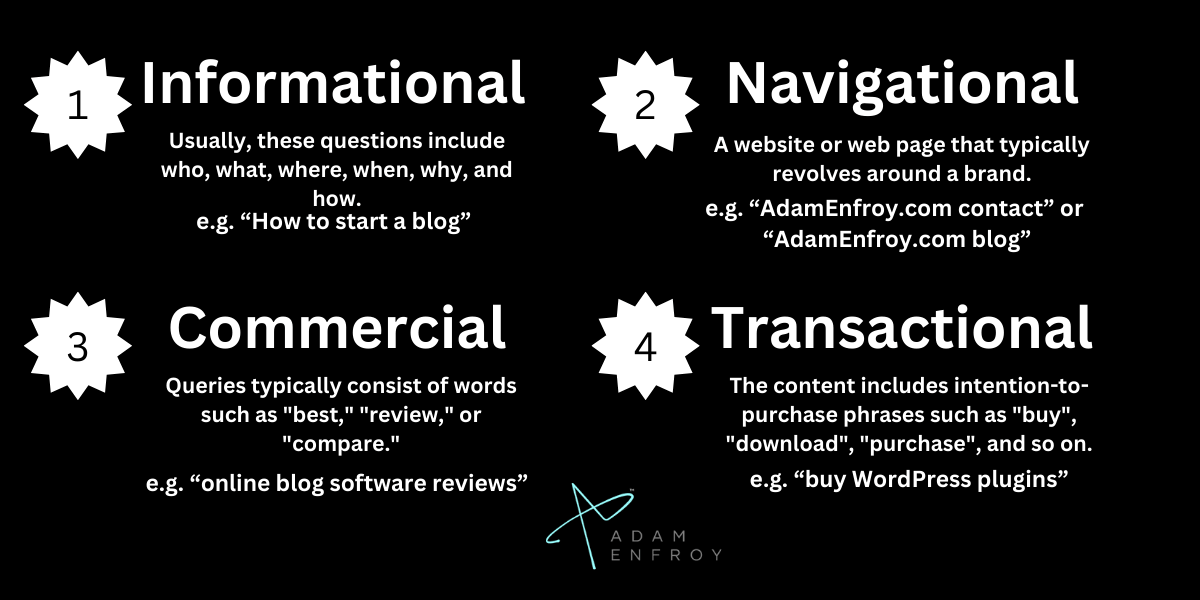
There are 4 main types of searches:
- Informational
- Navigational
- Commercial
- Transactional
Informational queries are when users want to learn something or find out more about a particular topic.
These are often questions such as “what is the difference between…” or “how do I …”
Navigational searches are when users want to find a certain website or page.
These might include the name of a company, product, or service.
Commercial searches are when users want to buy something.
They are searching for specific keywords related to a product they may be interested in buying.
Transaction searches reflect an intent to complete an online purchase by including words such as “buy” or “order” in their search query.
By understanding what type of searchers you’re targeting, you can create content that is more likely to be seen and clicked on by the right audience.
This increases the chances that your content will convert into leads or sales.
Consider that a user might start off with an informational query for research purposes.
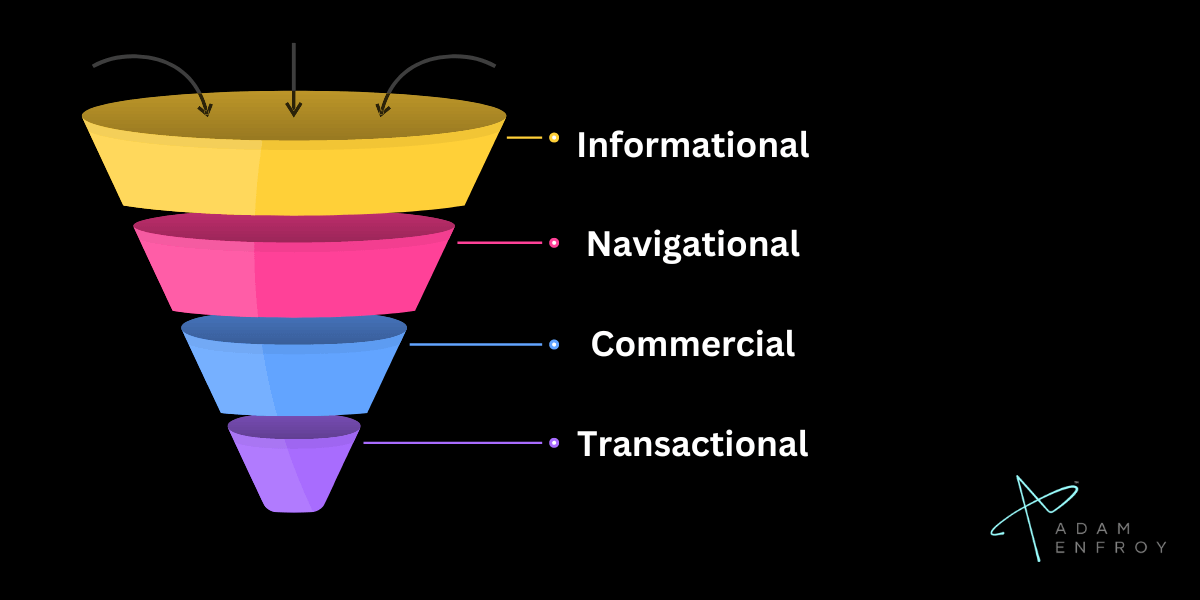
But if your content is tailored to their needs, they may eventually move on to a transaction search and convert into a customer.
Your content should aim to provide a seamless journey for your users, so they don’t have to search elsewhere for the information they need.
Make sure you cover all the relevant topics related to their query and include helpful visuals or videos where appropriate.
The AI Creation Process
Let’s now look at the actual content creation process.
Step 1: Review the top results in the SERPS
The top 3-5 search engine results have earned their high positions for a reason.
Taking the time to understand why pays off.
Firstly, pay close attention to their headings.
Headings provide valuable insights into the information that users find most relevant.
Matching search intent with your search analysis
After reviewing the top results, reflect on your initial findings.
Consider the search intent you determined.
Did the conclusions you drew align with the content in these top-ranking pages?
If not, reassess your understanding of the user’s search intent.
Remember, the goal is to provide superior information that answers the user’s query most effectively.
Are these pages fully serving the user’s needs, or is there room for improvement?
Your content must offer something better or different, answering the user query more effectively or providing additional, valuable information.
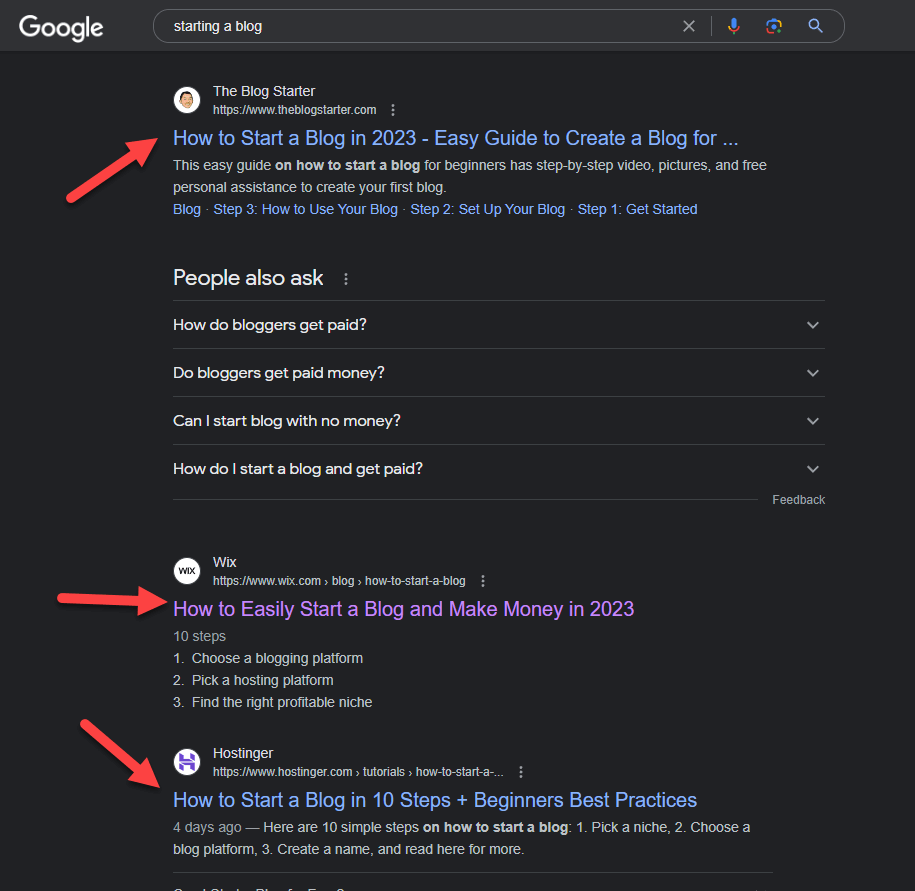
Step 2: Create an outline
An outline is the foundation for successful content creation. It helps you stay focused and organized, reducing writer’s block and improving writing.
An outline should start with a clear heading that reflects the user query.
It should then have subheadings addressing individual topics within the query.
Understanding and defining your document’s purpose is essential to creating an effective outline.
Ask yourself:
- “Why am I writing this?”
- “What do I want to achieve?”
You might want to inform your readers, persuade them about a particular viewpoint, or just entertain them.
Knowing your goal will guide the direction of your content.
Using Headings and Subheadings
Headings and subheadings are critical in organizing your outline (and final output).
They break down your content into manageable sections, making it easier for readers to understand the structure of your document.
They guide the reader through your content, highlighting the main points and allowing them to find information quickly.
Keeping it Logical
Ideas and points should flow naturally from one to the next in your content.
This logical progression helps guide your audience through the document, maintaining engagement and understanding.
If your points jump around without clear connections, your reader may lose interest or struggle to understand your message.
Revising and Refining
As your ideas evolve, be prepared to adjust your outline. An outline is a living document that should change with your ideas.
Revising and refining it will ensure it stays relevant and effective, meeting the needs of your audience and achieving your purpose.
The AI Prompt
Here is an AI outline prompt to consider:
Act as a content strategist and provide a detailed outline about [topic].
The search intent of the person reading this article is [search intent].
The introduction should hook the reader by mentioning [hook 1/2/3] and explaining what’s in it for the reader [provide additional details]. Then provide the outline for the main content going over the [main argument] shown by [supporting evidence] and [other main argument] shown by [supporting evidence]. I also want to explore the [topic] from the opposite perspective having a [counterargument] that is shown by [supporting evidence]. Finish with a conclusion involving [call to action].
Consider potential questions and themes related to the topic to ensure that the article is comprehensive and engaging. Your outline should have a mix of questions and statements. The questions and themes should be optimized with LSI and NLP* keyword logic to ensure that the article ranks well on search engine results pages. The outline should include 10-20 questions or themes that will cover everything the reader needs to know about the topic.
You should create an in-depth outline that explores all aspects of the topic while optimizing for Google ranking. Consider the target audience, their pain points as well as questions they ask most frequently regarding the topic. Be sure to include subtopics such as frequently asked questions (FAQs) that readers may search for and need answers on.
Focus on segmenting the content in a way that is easy to consume, such as breaking it down into subheadings, bullet points, and short paragraphs. Incorporate relevant stories, data points, and anecdotes that resonate with the readers’ interests.
*NLP stands for Natural Language Processing.
It refers to the technology used in artificial intelligence (AI) and machine learning.
Such technology allows machines to:
- understand human language
- interpret it
- and respond accordingly.
Here’s an outline example for the keyword “starting a blog”.
I used the above prompt to generate this outline.
Step 3: (Optional) Considering FAQs
FAQs are a chance to address common concerns or questions about your content.
Despite Google no longer showing FAQ search results, your readers still find them helpful.
A well-crafted FAQ section can enhance reader understanding and engagement.
Consider the questions people may be asking on platforms like Google, forums, Quora, or even the ones that pop up in your mind.
Incorporating these questions into your content proves you’ve considered the reader’s perspective.
You then provide the information that fulfills the reader’s search intent as best as possible.
Step 4: Do the AI dance to create the content
Now that you have the necessary information about AI content creation, you may wonder how to create great content.
The answer is: do the AI dance!
Select the Right AI Tool
I can’t stress enough the importance of selecting the right AI tool in content creation.
The appropriately chosen tool can completely transform your content workflow, enhancing efficiency and productivity.
Jasper.ai
Case in point: Jasper.ai has been a great help for several years.
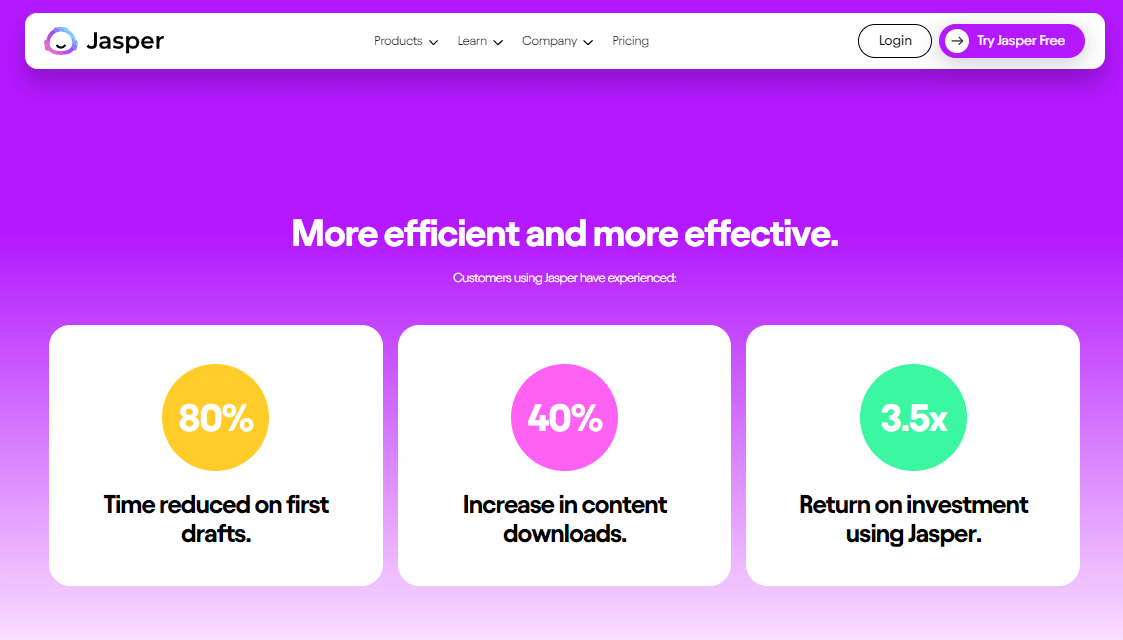
The variety of templates offered is invaluable.
A couple that really stand out are the Summarization and Content Improver templates.
You can quickly have AI summarize large text passages with the summarization template.
This helps when researching and writing summaries for blog posts or articles.
The Content Improver template is excellent for rewording sentences.
You can make your text more value-packed or make it easier to understand.
Jasper’s Boss Mode is another feature worthy of mention.
This feature provides an opportunity to give direct commands to the AI, allowing for a more streamlined and efficient creation process.
Boss Mode adapts to the commands, tailoring the output to the user’s needs.
Finally, there are Jasper recipes.
These are pre-built instructions to achieve a specific goal.
Super helpful when you know exactly what you want.
Pros:
- Jasper AI offers support for over 25 languages.
- The Jasper Academy helps streamline the creation process.
- The user-friendly interface and Boss Mode feature make content creation efficient.
Cons:
- There is a learning curve when using this software.
- Manual editing may still be necessary to ensure the desired level of quality.
ChatGPT for Creative Ideas

ChatGPT is fantastic for generating creative ideas.
It can spur innovation and fresh thinking in your content, keeping it engaging and impactful for your audience.
When you use Jasper and ChatGPT together, you can create truly remarkable content.
Your content becomes accurate and well-written.
You also get unlimited content ideas that engage your readers.
Pros:
- Generates new ideas for content quickly and easily.
- Potential to create unique, eye-catching content that stands out.
- AI technology ensures accuracy and speed.
- Helps keep your content fresh and interesting to readers.
Cons:
- May require trial and error to generate content you can use.
- Additional effort may be needed to ensure the AI generated content is accurate and relevant.
Quality Inputs for Quality Outputs
Regardless of the AI tool chosen, remember that the quality of your inputs is paramount.
The more accurate and detailed your input, the more relevant and helpful the output.
Investing time in crafting a well-thought-out input can significantly enhance your content’s quality and effectiveness.
Co-Creation Approach
The co-creation approach is a dynamic interaction process between AI and the user.
It’s akin to a dance where both parties contribute to the creative process.
Guiding the AI starts with clear and concise prompts.
This is your first step in the dance. Let the AI know what you want:
- Are you looking for an intro? Specify it.
- Is your goal a ‘how to’ article with four H3 headings? Spell it out.
The clarity in your prompts sets the stage for the AI’s response.
The dance doesn’t stop with the first prompt.
You step in again, review what the AI has provided and guide it further.
This could mean regenerating the output with better instructions if required.
Think of it as refining the dance steps to match the rhythm you have in mind.
This back-and-forth continues until you achieve the polished content you want.
As in a dance, it’s a continuous process of adjustment and improvement until both parties move perfectly in sync.
Recognizing Quality Content
Coherence is critical in creating quality content.
It ensures that ideas flow naturally, making it easy for readers to follow.
In our dance analogy, it’s about making sure the steps follow a clear rhythm and pattern.
When you review the AI’s output, check for coherence.
Pay attention to the logical progression of ideas and smooth transitions.
As the user, you are responsible for ensuring the factual accuracy of the content.
These AI models aren’t trained with up-to-date data.
You are responsible for ensuring the content is based on accurate facts.
Step 5: Engaging the Reader: The Intro And Conclusion
Let’s talk about prompts.
Suppose you’re writing a blog post about starting a blog.
Instead of asking the AI, “Write about the benefits of starting a blog,” you could ask, “Can you tell me a story about a person who found joy in starting a blog?”
This approach helps to craft content that is more captivating for the reader.
Starting with an anecdote is one way to engage the reader.
Another option is to ask a provocative question, use a powerful stat or quote, or create a meme related to the topic.
Whatever you choose, make sure it grabs your readers’ attention and encourages them to keep reading.
Once you’ve got the reader’s attention, your content has to deliver.
No one wants to waste time on an article that doesn’t provide value.
Make sure your content is:
- Informative
- Entertaining
- Or both.
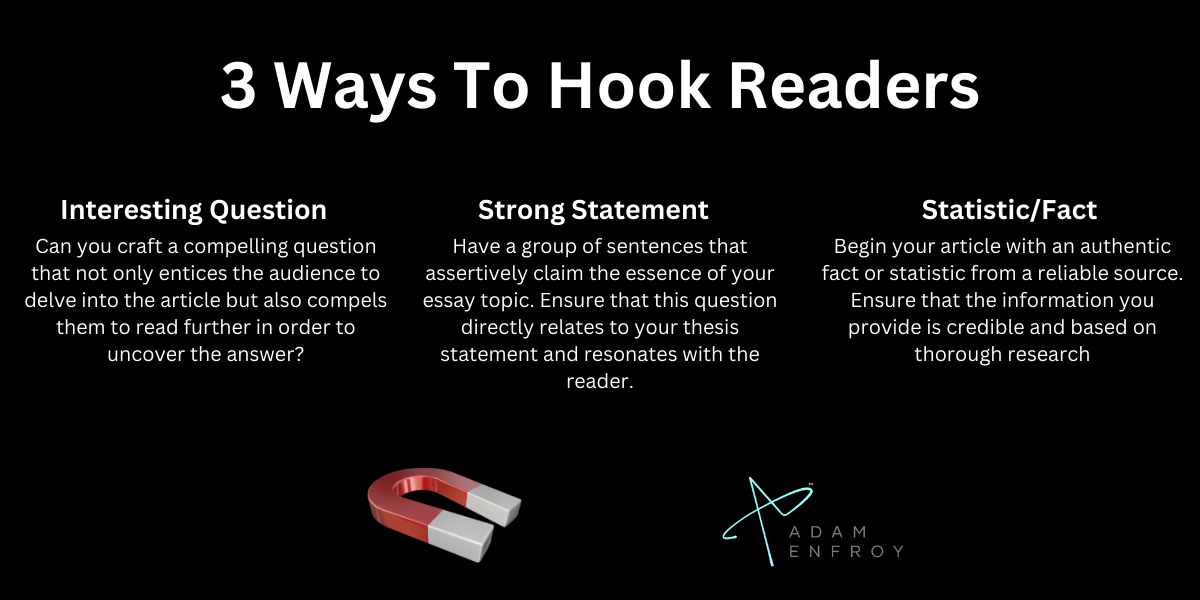
Above are some ideas to help create engaging hooks.
Finally, when it comes time to wrap up your article, consider the next logical step for your reader.
Will you:
- Offer them a related resource?
- A quiz or poll?
- Or do you want to refer them to another article on your blog/website?
Clearly state what the next action step for the reader should be.
A clear transition to the next action ensures readers never feel lost.
Step 6: Insert External Links
The final step in crafting a winning article is to insert external links.
This helps you become the authority in your niche.
You also provide resources to other valuable content that helps you achieve higher rankings.
If your post is about starting a blog, you could link to high DR (domain rating) websites with more detailed information about the topic.
Use natural anchor texts for easy readability.
The right anchor texts help readers know where they’ll end up when clicking on a link in your article.
Here’s an example:
“If you’re looking for more detailed information about starting a blog, here are the key steps to consider”.
Key Takeaways
Here are some key points to remember when creating content with an AI.
The Human Touch Is Key
Injecting a personal touch into your articles differentiates them from all other stuff online.
It’s not just about relaying facts or presenting data. It’s about engaging your reader in an authentic, conversational manner.
This approach builds a connection that makes your piece memorable.
The Power of Your Introduction
Your article introduction is key.
If it fails to captivate, readers will leave the article.
You will lose your site visitors regardless of how valuable the rest of the content might be
Prioritizing Quality over Quantity
The digital content landscape is evolving.
Nowadays, quality trumps quantity. Rather than producing a high volume of mediocre pieces, focus on creating fewer, high-quality articles that provide significant value to the reader.
This might sound ironic in an article talking about creating AI content.
However, if I had to start from scratch, I would consider the “quality” aspect more as I crafted my articles.
The Role of Outlines in Article Writing
Creating an outline is like setting up a roadmap for your article.
It keeps you on track throughout writing, ensuring a cohesive, well-structured piece.
An outline allows for systematically presenting ideas, enhancing your content’s clarity.
Understanding User Intent
User intent is a cornerstone of effective article writing.
You can structure your content to match their needs by understanding what your readers seek.
Not only does this increase engagement, but it also improves the relevancy of your work.
The Role of SEO Tools
SEO tools are beneficial in enhancing the visibility of your content.
However, they’re not a magic solution.
They should be used as an aid – not as the sole strategy for success.
Quality content and genuine reader engagement remain paramount.
Wrap Up.
Having a framework in place for bulk AI article content creation helps ensure quality and relevancy.
Following the above steps will enable you to create content with clarity and purpose.
Watch Next:





